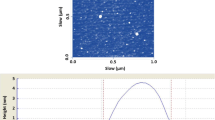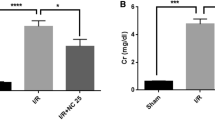Abstract
The protective effect of curcumin on potassium bromate (KBrO3)–induced renal damage was investigated in vivo. Treatment with KBrO3 (20 mg/kg bw) caused a significant increase in arginase and adenosine deaminase (ADA) activities in rats’ kidney. However, oral administration of curcumin (20 mg/kg bw) caused a significant reduction in ADA and arginase activities in KBrO3 + CUR group. Furthermore, nitric oxide level was significantly low in KBrO3 group compared with the control. After treatment with curcumin in KBrO3 + CUR group, nitric oxide levels increased significantly (P < 0.05). Determination of some kidney biomarkers revealed elevated levels of creatinine, serum urea, and electrolytes (Na+ and Cl−) in KBrO3-treated rats. Curcumin effectively reduced the levels of these renal function parameters in KBrO3 + CUR groups and were not significantly different from the control. Antioxidant enzyme activities such as superoxide dismutase (SOD), catalase (CAT), and glutathione peroxidase (GPX) activities as well as glutathione (GSH) levels were significantly low with concomitant higher levels of malondialdehyde (MDA) after treatment with KBrO3. Curcumin caused a significant increase in SOD, CAT, and GPX activities including GSH levels with lower production of MDA in kidney homogenates of rats in KBrO3 + CUR. Curcumin ameliorated corpuscular degeneration in the kidney tissue and exhibited protection against tubular necrosis. These results revealed the protective effect of curcumin against KBrO3-induced renal toxicity by preventing degradation of ADA and arginine, improving antioxidant status and histopathological changes in rats’ kidney.






Similar content being viewed by others
References
Xu X, Nie S, Ding H, Hou FF (2018) Environmental pollution and kidney diseases. Nat Rev Nephrol 14(5):313–324
Dennis JM, Witting PK (2017) Protective role for antioxidants in acute kidney disease. Nutrients 9(7)
Afsar B, Elsurer Afsar R, Kanbay A, Covic A, Ortiz A, Kanbay M (2019) Air pollution and kidney disease: review of current evidence. Clin Kidney J 12(1):19–32
Orr SE, Bridges CC (2017) Chronic kidney disease and exposure to nephrotoxic metals. Int J Mol Sci 18(5)
Fevrier-Paul A, Soyibo AK, Mitchell S, Voutchkov M (2018) Role of toxic elements in chronic kidney disease. J Heal Pollut 8(20)
Khan RA, Khan MR, Sahreen S (2012) Protective effects of rutin against potassium bromate induced nephrotoxicity in rats. BMC Complement Altern Med 12(1):1
Kurokawa Y, Takamura N, Matsuoka C, Imazawa T, Matsushima Y, Onodera H, Hayashi Y (1987) Comparative studies on lipid peroxidation in the kidney of rats, mice, and hamsters and on the effect of cysteine, glutathione, and diethyl maleate treatment on mortality and nephrotoxicity after administration of potassium bromate. Int J Toxicol 6(4):489–501
Bagchi A (2012) Extraction of curcumin. IOSR J Environ Sci Toxicol Food Technol 1(3):01–16
Kuhad A, Pilkhwal S, Sharma S, Tirkey N, Chopra K (2007) Effect of curcumin on inflammation and oxidative stress in cisplatin-induced experimental nephrotoxicity. J Agric Food Chem 55(25):10150–10155
Strimpakos A, Sharma R (2008) Curcumin: preventive and therapeutic properties in laboratory studies and clinical trials. Antioxid Redox Signal 10(3):511–545
Nabavi SF, Moghaddam AH, Eslami S, Nabavi SM (2012) Protective effects of curcumin against sodium fluoride-induced toxicity in rat kidneys. Biol Trace Elem Res 145(3):369–374
Venkatesan N, Punithavathi D, Arumugam V (2000) Curcumin prevents adriamycin nephrotoxicity in rats. Br J Pharmacol 129(2):231–234
Akinyemi AJ, Onyebueke N, Faboya OA, Onikanni SA, Fadaka A, Olayide I (2017) Curcumin inhibits adenosine deaminase and arginase activities in cadmium-induced renal toxicity in rat kidney. J Food Drug Anal 25(2):438–446
Guisti G, Galanti B (1984) Colorimetric method. In: Bergmeyer HU (ed) Methods of enzymatic analysis. Verlag Chemie, Weinheim, pp 315–323
Romero MJ, Platt DH, Tawfik HE, LAbazi M, El-Remessy AB, Bartoli M, Caldwell RB, Caldwell RW (2008) Diabetes-induced coronary vascular dysfunction involves increased arginase activity. Circ Res 102:95–102
Claiborne A (1985) Catalase activity. In: Greenwald RA (ed) CRC Handbook of methods for oxygen radical research. CRC Press, Boca Raton, pp 283–284
Misra H (1989) Adrenochrome assay. In: Greenwald R (ed) Handbook of methods for oxygen radical research. CRC Press, Boca Raton, pp 237–242
Paglia D, Valentine W (1967) Studies on the quantitative and qualitative characterization of erythrocyte glutathione peroxidase. J Lab Clin Med 70(1):158–169
Lowry OH, Rosenbrough NJ, Lewis FA, Randall RJ (1951) Protein measurement with the Folin reagent. J Biol Chem 193(1):262–275
Jollow D, Mitchell J, Zampaglione N, Gillette J (1974) Bromobenzene-induced liver necrosis. Protective role of glutathione and evidence for 3,4-bromobenzene oxide as the hepatotoxic metabolite. Pharmacology 11:151–169
Ohkawa H, Ohishi N, Yagi K (1979) Assay for lipid peroxides in animal tissues by thiobarbituric acid reaction. Anal Biochem 95(2):351–358
Vallon V, Mühlbauer B, Osswald H (2006) Adenosine and kidney function. Physiol Rev 86(3):901–940
Cristalli G, M CE, Volpini R (2009) Recent developments in adenosine A. Handb Exp Pharmacol. p123–59
Rabadi MM, Lee HT (2015) Adenosine receptors and renal ischaemia reperfusion injury. Acta Physiol 213(1):222–231
You H, Gao T, Cooper TK, Morris SM, Awad AS (2013) Arginase inhibition mediates renal tissue protection in diabetic nephropathy by a nitric oxide synthase 3-dependent mechanism. Kidney Int 84(6):1189–1197
Reddy YS, Kiranmayi VS, Bitla AR, Krishna GS, Srinivasa Rao PVLN, Sivakumar V (2015) Nitric oxide status in patients with chronic kidney disease. Indian J Nephrol 25(5):287–291
Gowda S, Prakash BD, Shruthi SK, Vinayak VH, Avinash AM, Sonal NV Markers of renal function tests. N Am J Med Sci 2(4):170–173
Khan N, Sharma S, Sultana S (2004) Attenuation of potassium bromate-induced nephrotoxicity by coumarin (1,2-benzopyrone) in Wistar rats: chemoprevention against free radical-mediated renal oxidative stress and tumor promotion response. Redox Rep 9(1):19–28
Ali BH, Al Za’abi M, Karaca T, Al Suleimani Y, Al Balushi KA, Manoj P, Ashique M, Nemmar M (2018) Potassium bromate-induced kidney damage in rats and the effect of gum acacia thereon. Am J Transl Res 10(1):126–137
Modaresi A, Mohsen N, Sahraei Z (2015) Oxidative stress in chronic kidney disease. Iran J Kidney Dis 9(3):165–179
Author information
Authors and Affiliations
Corresponding author
Ethics declarations
The Institution’s (Osun State University Oshogbo, Nigeria) animal ethics committee approved the use of animals for this study.
Conflict of Interest
The authors declare that they have no conflict of interest.
Additional information
Publisher’s Note
Springer Nature remains neutral with regard to jurisdictional claims in published maps and institutional affiliations.
Rights and permissions
About this article
Cite this article
Akomolafe, S.F., Olasehinde, T.A., Adewale, O.O. et al. Curcumin Improves Biomolecules Associated with Renal Function and Attenuates Oxidative Injury and Histopathological Changes in Potassium-Induced Toxicity in Rats’ Kidney. Biol Trace Elem Res 199, 197–204 (2021). https://doi.org/10.1007/s12011-020-02113-y
Published:
Issue Date:
DOI: https://doi.org/10.1007/s12011-020-02113-y




